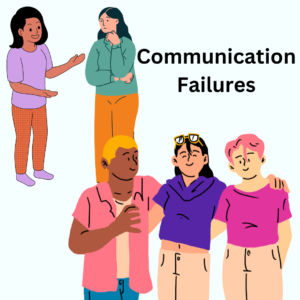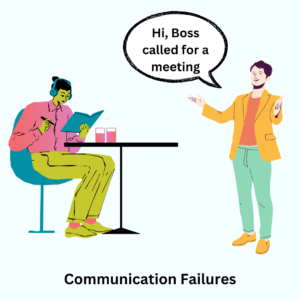Review the case below, analyze it, and then create a report:
Interpersonal Communication

Ms. Shina oversaw the administrative division of a large company. There were a lot of female typists. They were all proficient at their jobs and completed all of their daily tasks before leaving the workplace. There was no need for typing labour in this portion to be done after hours.
The manager of the administration department, Mr. Mohan, was summoned one day by the company’s managing director, who told him that people in his division had begun to err on the side of laxity when it came to being on time for work.
He said that on one specific day, around 9.40 in the morning, he arrived at work and saw two stenos/typists arriving late. He claimed that this was not the first time he had seen this.
He desired that his managers become knowledgeable in this area. Mr. Mohan committed to maintain timeliness after carefully listening to the Managing Director’s directions.
Check here for latest case studies and research book : https://kit.co/Anurooba/case-analysis-text-books
When the two latecomers event occurred, Mr. Mohan phoned Ms. Shina to inform her of the situation and the Managing Director’s remarks. Additionally, he said that timeliness must always be respected. Ms. Shina said that while she was aware of the circumstances, she did not believe that any action was necessary.
She said that the stenos/typists put in a lot of effort and did not mind staying late for a few hours in the office if there was a lot of work to be done. They were determined to accomplish the day’s work before leaving the workplace, and they normally kept their appointments and did not often arrive late.

She also argued that in the interest of excellent functioning, it should not be taken into account when one or two typists are sometimes ten to fifteen minutes late due to personal reasons.Nevertheless, Mr. Mohan demanded that she follow the Managing Director’s directions.
Ms. Shina became confused. The Managing Director urged them to be at the office on time and is opposed to any relaxation in this regard, so she returned to her area and told her typists the full scenario. She also warned them that the latecomers would face punishment.

This did not make the typists happy. Since they were the typists who arrived later that day, Ms. Sarla and Ms. Rama spoke about this issue at lunch. They believed they had not received sufficient care.
It is extremely odd that things have been gone too far, Ms. Sarla added. I’ve made up my mind to leave the workplace at 5.30 p.m. if I’m requested to stay later than that and leave the job undone.
Just two days later, at 5:15 p.m., the Managing Director’s Private Secretary delivered Ms. Rama some urgent typing work. To type the whole document would take at least two typists an hour.
With these crucial documents, the Managing Director was scheduled to meet with the Chairman in the evening. In any event, he needed the typed document returned by 6.30 p.m.

Ms. Shina gave Ms. Sarla and Ms. Rama the task, but both said they could not do it since it would take an hour to complete and they could only remain in the office for a maximum of fifteen minutes.
At 5.30 p.m., the office shuts. Since “the commanders sometimes urged them to sit late, why such hue and cry should have been created when someone was late by a few minutes and that too on a few occasions,” both typists did not forget to ask.
Ms. Shina had trouble getting the materials typed. She worried that other typists may respond in the same way. She then returned to the Private Secretary and informed the Managing Director that she and the Private Secretary may need to split the job and complete it even though the Private Secretary had other more important tasks to do.
QUESTIONS
(a) What do you think of Ms. Rama, Ms. Sarla, and Ms. Shina’s actions?
(b) Has there been a communication breakdown? If so, how and where?
(c) How can this scenario be made better?
(d) What are your thoughts about the Managing Director’s demeanour?
(e) How do you see Mr. Mohan’s demeanour?
(f) In such a circumstance, how would you respond?
SOLVING THE CASE

Brief Description of the Case
Ms. Shina oversees a team of female typists in a large company, where the workers are efficient and complete their tasks on time. However, the Managing Director observed that some typists, including Ms. Sarla and Ms. Rama, were occasionally arriving late, prompting him to raise concerns about punctuality with Mr. Mohan, the administration manager.
Mr. Mohan, in turn, asked Ms. Shina to address the issue, but she initially dismissed it as unnecessary since the typists always finished their work. This led to frustration among the typists, who felt unfairly criticized.
When asked to stay late to complete urgent work, Ms. Sarla and Ms. Rama refused in protest, citing the inconsistency of management’s approach to lateness versus staying late.
Ms. Shina struggled to resolve the conflict while trying to meet the Managing Director’s expectations. Eventually, she warned the typists that further lateness would lead to consequences, but the overall situation highlighted deeper issues of communication, employee dissatisfaction, and managerial challenges.
Problem Description
The issue revolves around punctuality and communication failures in a large company’s administrative division. The Managing Director observed late arrivals by the typists, raising concerns about their discipline.
Despite the typists’ efficiency and the completion of their tasks, the emphasis was placed on their punctuality. The tension escalated when two typists, Ms. Sarla and Ms. Rama, refused to stay late for urgent work as a form of protest against being called out for minor instances of tardiness. The managers—Ms. Shina and Mr. Mohan—struggled to balance the demands for punctuality and work completion.
Brief Description of the Problems:
- Punctuality Issues: The Managing Director noticed that some typists were arriving late to work, which he viewed as a sign of growing laxity, even though their work was consistently completed on time.
- Communication Breakdown: There was poor communication between management and employees regarding expectations about punctuality and flexibility in staying late for urgent work. This led to misunderstandings and resentment, particularly among the typists.
- Employee Dissatisfaction: The typists, particularly Ms. Sarla and Ms. Rama, felt undervalued and unfairly criticized for minor lateness, despite their hard work and willingness to stay late when needed. Their dissatisfaction escalated into a refusal to cooperate during a critical task.
- Managerial Conflict: Ms. Shina struggled to balance the demands of her superior, Mr. Mohan, and the expectations of her team. This created confusion and tension as she was caught between enforcing punctuality and acknowledging the typists’ contributions.
SWOT Analysis
Strengths:
- Efficiency of Typists: All typists, including Ms. Sarla and Ms. Rama, are highly proficient and ensure their daily tasks are completed before leaving.
- Strong Team Spirit: The typists are generally willing to stay late when work demands are high.
- Leadership Commitment: Both Ms. Shina and Mr. Mohan are focused on maintaining discipline and productivity.
Weaknesses:
- Punctuality Issues: Some typists, including Ms. Sarla and Ms. Rama, are arriving late, which the Managing Director finds problematic.
- Communication Breakdown: The issue of lateness and after-hours work expectations is poorly communicated, causing resentment among employees.
- Poor Handling of Feedback: Ms. Shina’s initial reaction to the punctuality issue did not address the typists’ concerns, making them feel unvalued.
Opportunities:
- Enhanced Communication: Implementing better communication channels could improve the relationship between managers and typists.
- Policy Clarification: Establishing clear guidelines for punctuality and after-hours work could help set expectations and reduce confusion.
- Employee Motivation: Recognizing the efforts of typists when they stay late could enhance morale and promote punctuality.
Threats:
- Employee Dissatisfaction: The current frustration with management could lead to decreased motivation and future conflicts.
- Work Delays: If typists refuse to stay late for urgent tasks, critical work may be delayed.
- Escalation of Conflict: The punitive approach towards tardiness could escalate tension, leading to high employee turnover or strikes.
Answers to the Questions
(A) What do you think of Ms. Rama, Ms. Sarla, and Ms. Shina’s actions?
- Ms. Rama and Ms. Sarla: Their protest by refusing to stay late highlights a larger issue of feeling undervalued. They believe the lateness issue is minor compared to the flexibility they usually show, which suggests that they feel unfairly treated.
- Ms. Shina: While she is trying to balance discipline and productivity, her initial dismissal of the lateness issue may have contributed to the growing dissatisfaction. Later, she recognized the need to communicate better with her team but was still caught in the middle of conflicting demands.
(a) Has there been a communication breakdown? If so, how and where?
Yes, the communication breakdown occurred:
- Between management and employees: The typists were not informed clearly about the company’s strict expectations on punctuality, especially when their work performance was otherwise efficient.
- Between Mr. Mohan and Ms. Shina: There seems to be a lack of a cohesive message on how to handle tardiness. Ms. Shina did not emphasize the importance of punctuality to her team, creating confusion.
- Between Ms. Shina and the typists: Ms. Shina’s delayed response to the Managing Director’s concerns and the typists’ dissatisfaction resulted in mistrust.
How can this scenario be made better?
- Clear Policy on Punctuality: There needs to be an explicit policy regarding arrival times, with a balance of flexibility for personal issues.
- Better Communication Channels: A meeting between the typists and management should be organized to discuss expectations and concerns openly, ensuring employees feel heard.
- Recognition and Flexibility: Acknowledging the typists’ hard work while setting fair expectations for punctuality would help to improve morale and discipline.
(d) What are your thoughts about the Managing Director’s demeanour?
The Managing Director is focused on discipline and is concerned about lateness, which is understandable from a leadership perspective. However, his approach could be more flexible. Focusing solely on punctuality without considering the team’s productivity might seem rigid. A more balanced approach that recognizes both punctuality and hard work would help foster a positive work environment.
(e) How do you see Mr. Mohan’s demeanour?
Mr. Mohan is caught between following the Managing Director’s orders and supporting his team. He seems to be taking a strict stance on punctuality because he is under pressure from the top, but he does not appear to have offered much flexibility or support to his employees, making him seem somewhat distant from their concerns.
(f) In such a circumstance, how would you respond?
If I were in this situation, I would:
- Hold a meeting with the typists to clarify expectations about punctuality and after-hours work, ensuring that employees understand the company’s requirements.
- Encourage open communication where employees can express their concerns without fear of punishment.
- Develop a fair policy that balances productivity with personal flexibility, recognizing that occasional lateness can be managed if overall performance remains high.
Three Solutions to Solve the Problem
- Implement a Flexible Work Policy:
- How it works: Introduce a system where employees are allowed occasional flexibility in arrival times, with the understanding that they make up the lost time within the same day or week. Establish a clear framework for when flexibility is allowed, such as for personal reasons, while ensuring that employees consistently meet overall productivity targets.
- Why it works: This addresses the typists’ dissatisfaction over strict punctuality rules, while still maintaining a focus on the timely completion of work. It acknowledges that life circumstances sometimes interfere with punctuality but balances this with professional responsibilities.
- Improve Communication and Feedback Channels:
- How it works: Organize regular meetings between management and the typists where expectations and feedback can be openly discussed. Managers should clearly communicate any new policies, expectations regarding work hours, and their reasons. Employees should also have a space to voice concerns or suggest improvements without fear of backlash.
- Why it works: Clear communication helps prevent misunderstandings, like those between Ms. Shina, Mr. Mohan, and the typists. It also promotes a culture of transparency and trust, allowing employees to feel heard and valued.
- Introduce a Recognition and Rewards Program:
- How it works: Create a system where employees are acknowledged for both their punctuality and their dedication when staying late for urgent work. Rewards can be in the form of time off, bonuses, or public recognition during staff meetings.
- Why it works: Positive reinforcement encourages both punctuality and willingness to stay late when necessary. Recognizing the extra effort put in by typists can increase motivation and reduce resentment, as employees will feel appreciated rather than solely critiqued for minor lateness.
Steps to Implement:
- Meet with staff to clarify expectations and discuss the new flexible work policy.
- Set up regular communication sessions to keep everyone on the same page.
- Launch the recognition program to boost morale and motivate staff towards punctuality and dedication.
- Ensure fair and consistent enforcement of both punctuality and rewards for extra work, keeping a balanced approach.
Other Related Topics
- How to Solve a Case Study or Analyse a Case?
- Case Study / Analysis on Communication : Case 1
- Case Study on Co-ordination: Case 2
- Case study on Selection : Case 3
- Case study on Role Reversal : Case 4
- Case study of a Controversial Person : Case 5
- Case Study on Co-ordination: Case 6
- Case Study on Punishment and Discipline: Case 7
- Case Study on Personal Conflicts: Case 8
- Case Study on Human Aspects of Personnel – Case 9
- Case Study on Inter-Personal Relationships- Case 10
- Case Study on Schemes : Case 11
- Case Analysis on sales : Case 12
- Case Analysis on Diversity : Case 13

